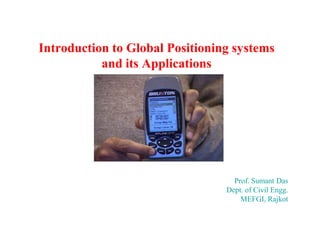
GPS Basics: How it Works and Its Applications
- 1. Introduction to Global Positioning systems and its Applications Prof. Sumant Das Dept. of Civil Engg. MEFGI, Rajkot
- 2. Global Positioning System (GPS)
- 3. Global Positioning System (GPS) In 1973 the U.S. Department of Defense decided to establish, develop, test, acquire, and deploy a spaceborne Global Positioning System (GPS). The result of this decision is the present NAVSTAR GPS (Navigation Satellite Timing And Ranging Global Positioning System).
- 4. Definition of GPS: The Global Positioning System (GPS) is a worldwide satellitebased radio navigation system formed from a constellation of 24 satellites and their ground stations. It’s used to determine accurate geodetic position & altitude on the earth surface.
- 5. GPS General Characteristics Developed by the US Department of Defense Provides Accurate Navigation 10 - 20 m Worldwide Coverage 24 hour access Common Coordinate System 20,200 Km above the Earth Designed to replace existing navigation systems Accessible by Civil and Military
- 6. Basic Principles of GPS: The GPS System Consists of 24 Satellite that broadcast Signals containing information about their position and time. A GPS receiver processes signal from at least 4 Satellites. The GPS system and receiver is the constancy of the speed of light.
- 7. GPS – How it works All satellites have clocks set to exactly the same time. All satellites know their exact position in space from data sent to them from the systems controllers. Each satellite transmits its position and a time signal. The signals travel to the receiver delayed only by distance traveled. The receiver calculates the distance to each satellite and trilaterates its own position.
- 12. Types: Single frequency- Static mode GPS surveying Dual frequency- requires post processing only.
- 13. GPS Segments Space Segment Space Segment 24 Satellites 4 satellites in 6 Orbital Planes inclined at 55 Degrees 20200 Km above the Earth 12 Hourly orbits In view for 4-5 hours Designed to last 7.5 years Different Classifications Block 1, 2, 2A, 2R & 2 F Control Segment User Segment Control Segment 1Master Control Station Responsible for collecting tracking data from the monitoring stations and calculating satellite orbits and clock parameters 2.5 Monitoring Stations Responsible for measuring pseudorange data. This orbital tracking network is used to determine the broadcast ephemeris and satellite clock modeling Ground Control Stations Responsible for upload of information to the satellites User Segment 1.The most visible segment 2 GPS receivers are found in many locations and applications
- 14. Three Segments of the GPS Space Segment User Segment Control Segment Ground Antennas Master Station Monitor Stations
- 15. Space Segment 4 satellites in 6 Orbital Planes inclined at 55 Degrees • 12 Hourly orbits 24 Satellites 20200 Km above the Earth Orbits Equator 4 55 3 2 1 Satellites – In view for 4-5 hours • Designed to last 7.5 years • Different Classifications – Block 1, 2, 2A, 2R & 2 F
- 16. Control Segment Monitor and Control Colorado Springs Hawaii Master Control Station Monitor Station Ground Antenna Kwajalein Ascension Islands Diego Garcia
- 17. Control Segment Master Control Station Responsible for collecting tracking data from the monitoring stations and calculating satellite orbits and clock parameters 5 Monitoring Stations Responsible for measuring pseudorange data. This orbital tracking network is used to determine the broadcast ephemeris and satellite clock modeling Ground Control Stations Responsible for upload of information to the satellites
- 18. User Segment The most visible segment GPS receivers are found in many locations and applications
- 19. GPS Segments Space Segment Satellite Constellation User Segment Ground Antennas Monitor Stations Master Control Station AFSCN FAIRBANKS Control Segment ENGLAND COLORADO SPRINGS SOUTH KOREA USNO WASH D.C. VANDENBERG, AFB CAPE CANAVERAL Master Control Station (MCS) Ground Antenna (GA) Advanced Ground Antenna Monitor Station (MS) BAHRAIN HAWAII Master Control Station KWAJALEIN ASCENSION ECUADOR National Geospatial-Intelligence Agency (NGA) Tracking Station GeospatialAlternate Master Control Station (AMCS) ARGENTINA DIEGO GARCIA TAHITI SOUTH AFRICA NEW ZEALAND
- 20. Who Uses It? Everyone! Merchant, Navy, Coast Guard vessels Commercial Airliners, Civil Pilots Surveyors Commercial Truckers Cars now being equipped Communications and Imaging Satellites Space-to-Space Navigation Any system requiring accurate timing
- 21. Application of GPS Power Grid Interfaces Precision farming Personal Navigation Trucking & Shipping Surveying & Mapping Aviation Railroads Recreation Off shore Drilling Communications Fishing & Boating
- 22. Applications Civilian Purpose Locations Mapping Monitoring Construction Control Emergency services Boundaries Agriculture - Slope Staking Tracking of people, vehicles Sports (boating, hiking,…) Archeology Public Transport Town Planning Hydrographic Surveying Topographical Mapping Cadastral Surveying GIS Application
- 23. Defense Application Navigation (night & bad weather) Call in target coordinates Guidance system for missiles Ships used them for minesweeping, rendezvous, and aircraft operations
